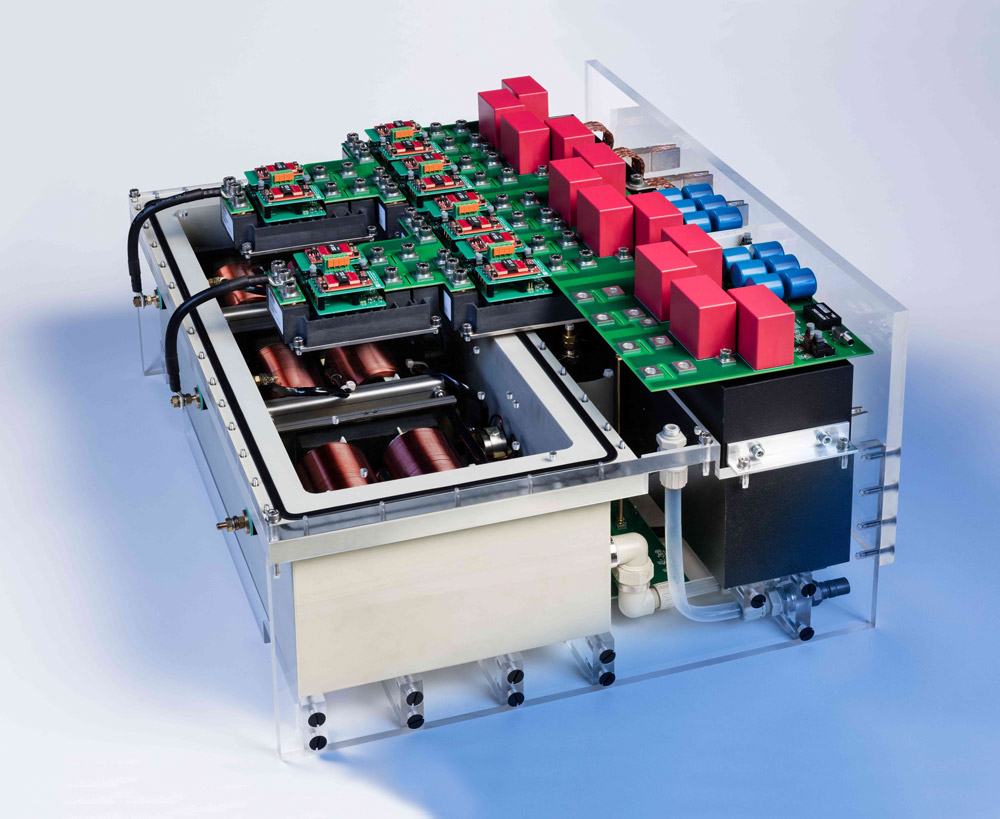News: Microelectronics
25 January 2021
Fraunhofer ISE develops compact inverter for direct connection to medium-voltage grid
As the energy transition progresses, the expansion of the electricity grids is becoming increasingly important, notes Fraunhofer Institute for Solar Energy Systems ISE of Freiburg, Germany. More and more renewable generation plants as well as electrical storage systems are being connected to the grid. This gives power electronics a decisive role, because it is essential to connect these systems to the grid. However, in addition to the mere feed-in or feed-back of electrical energy, power electronics must also perform other grid-supporting tasks. In the project ‘SiC-MSBat - medium-voltage inverters with high-voltage SiC power modules for large-scale storage and system-serving distribution grids’, researchers at the Fraunhofer ISE, together with partners, have now developed and commissioned a highly compact inverter for direct feeding into the medium-voltage grid.
Currently, inverters mostly feed into the low-voltage grid. They are then coupled to the medium-voltage grid via large 50Hz transformers. The use of new types of silicon carbide (SiC) transistors with very high blocking voltages now also makes it possible to connect the inverters directly to the medium-voltage grid.
Thanks to the high control dynamics of SiC inverters, they can take on grid-stabilizing tasks and, for example, act as active power filters to compensate for harmonics in the medium-voltage grid.
Furthermore, SiC inverters can achieve much higher power densities than conventional inverters. This results in a compact design, which is a particular advantage when plants are to be built in inner-city areas or existing old plants are to be retrofitted. In addition to the mere system costs, construction and infrastructure costs also play a very important role, especially in urban areas.
Compact design due to high switching frequency
As part of the SiC-MSBat project, a 250kW inverter stack was developed for feeding into 3kV AC grids.
Here, novel 3.3kV SiC transistors are used. These have significantly lower power losses than comparable silicon transistors. This makes it possible to operate the inverter stack with a switching frequency of 16kHz. With state-of-the-art silicon transistors, only about 10 times lower switching frequencies are possible in this voltage class, says Fraunhofer ISE. The high switching frequency provides savings on the passive components, as these can be dimensioned in a smaller format.
Another special feature of the inverter is its active liquid cooling with a synthetic ester as cooling medium. This medium is pumped through the inverter and cools both the transistors via a liquid heat sink and the filter chokes, which are housed in a closed tank. At the same time, the cooling medium for the filter chokes serves as an electrical insulation medium, allowing the filter chokes to be made even more compact.

Picture: A 250kVA inverter stack with 3.3kV SiC-transistors developed at Fraunhofer ISE.
The inverter was built and tested in Fraunhofer ISE’s laboratories, achieving a very high efficiency rate of 98.4% at rated power. The design of the device allows modular interconnection of multiple inverter stacks to achieve system outputs of several megawatts. Taking into account additional installation space for switchgear and cooling unit, a volume saving of the inverter system of up to 40% can be achieved compared to commercial inverter systems of this voltage class.
The project was funded by the German Federal Ministry for Economic Affairs and Energy (BMWi) as part of the 6th Energy Research Program under the sub-area ‘Integration of Renewable Energies and Regenerative Energy Supply Systems’. Project partners were Semikron Elektronik GmbH & Co KG and STS Spezial-Transformatoren Stockach GmbH. Semikron was responsible for the development of the 3.3kV SiC modules in the project, while STS was mainly responsible for the inductive components.
Future power electronics at the medium-voltage level
Fraunhofer ISE sees many potential applications for the use of high-blocking SiC devices in the medium-voltage range. “Especially for large photovoltaic (PV) power plants, the trend is towards higher and higher voltages,” says Andreas Hensel, head of team Medium Voltage Power Electronics. “With the 1500V PV technology that has been available for a few years, the low-voltage directive is already being fully exploited. The next step here will be the transition to feed-in at medium-voltage level, which will bring further potential for savings and improvements in the system concept of PV power plants.”
In addition to regenerative power plants and large battery storage systems, other areas of application for medium-voltage power electronics include drive systems and rail technology.
For testing such systems, Fraunhofer ISE has the multi-megawatt laboratory, which was inaugurated in mid-2019. This enables the operation of medium-voltage systems with a power of up to 20MVA.
Silicon carbide transistors improve efficiency in home storage systems
Fraunhofer ISE inaugurates Center for Power Electronics and Sustainable Grids









